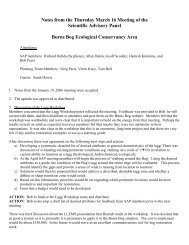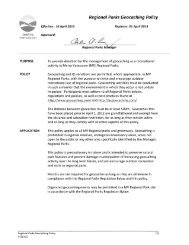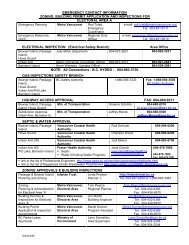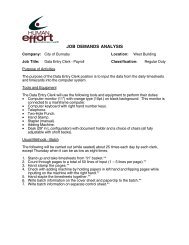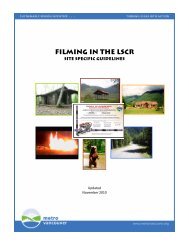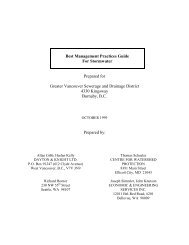Chlorine Monitoring and Dechlorination Techniques Handbook
Chlorine Monitoring and Dechlorination Techniques Handbook
Chlorine Monitoring and Dechlorination Techniques Handbook
Create successful ePaper yourself
Turn your PDF publications into a flip-book with our unique Google optimized e-Paper software.
2.1 Background<br />
<strong>Chlorine</strong> <strong>Monitoring</strong> <strong>and</strong> Dechlorinating <strong>Techniques</strong> H<strong>and</strong>book<br />
CHLORINE MONITORING<br />
<strong>Monitoring</strong> for free residual chlorine <strong>and</strong> total residual chlorine (ie. free available plus<br />
combined available chlorine) is a requirement during most dechlorination efforts. The<br />
concentration of residual chlorine in the discharge water will determine if dechlorination<br />
techniques are required, <strong>and</strong> the dosing rate of the dechlorinating agent. The following<br />
sections outline the procedures for monitoring the residual chlorine levels in municipal<br />
water.<br />
2.2 Chemical Analysis<br />
<strong>Chlorine</strong> concentrations can be measured either in the field using simple field kits or in the<br />
laboratory using more sophisticated procedures <strong>and</strong> equipment. Most field kits work from<br />
a similar principal where a chemical (ie. an indicator) is added to a water sample <strong>and</strong> the<br />
colour of the solution is compared to a set of coloured st<strong>and</strong>ards. The colours in the st<strong>and</strong>ards<br />
have been calibrated in a laboratory to match set concentrations of chlorine. For instance, if<br />
a water sample is placed in a glass vial containing an indicator, <strong>and</strong> the solution turns dark<br />
red, this indicates a higher concentration than if the solution turns faint pink.<br />
The limitation to field kits is their detection limits. The detection limit is typically 0.1 ppm,<br />
which is well above environmentally safe levels. The free chlorine concentrations which<br />
have killed fish vary from 0.03 mg/L to 0.05 mg/L depending on exposure time <strong>and</strong> fish<br />
species. However, even though it cannot be quantified, these kits can identify trace<br />
concentrations of chlorine if a faint colour is present. <strong>Dechlorination</strong> should be undertaken<br />
with any sign of colour. Laboratory methods, on the other h<strong>and</strong>, have lower detection limits,<br />
but are generally not applicable because the chlorine dissipates more quickly <strong>and</strong> will be lost<br />
during transport (unless it s in the combined chlorine form).<br />
Examples of the types of field kits available <strong>and</strong> laboratory procedures are given in the<br />
following sections. The field kits can be purchased from local scientific equipment suppliers.<br />
The suppliers will provide current pricing <strong>and</strong> availability of product. The larger suppliers<br />
have websites on the Internet where information on the field kits can be obtained (see<br />
Appendix A for names, addresses, <strong>and</strong> website addresses).<br />
2.2.1 Orthotolidine Indicator<br />
One sampling kit uses a liquid indicator called orthotolidine. The kit includes sampling<br />
vials of preset volumes. The sampler places the water to be tested into the sampling vial <strong>and</strong><br />
Page 6




